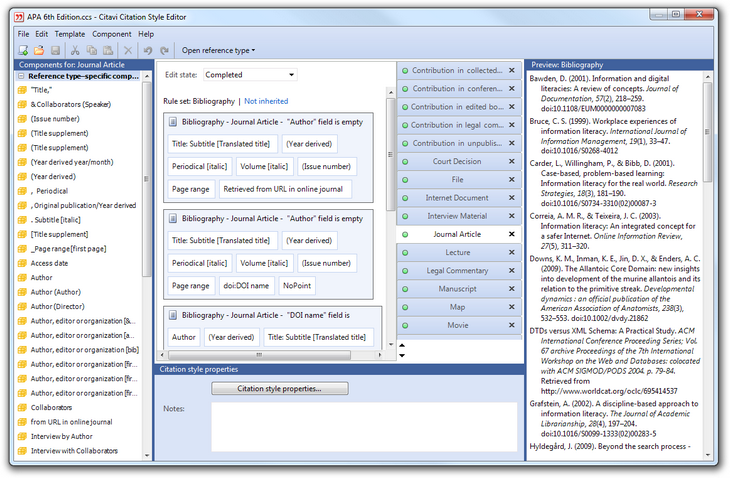The Citation Style Editor |

|

|
The citation style editor is the tool you use to create a new style by either modifying an existing style or starting a new one from scratch. Before you begin working on a style, be sure you read the preceding chapter, Anatomy of a Citation Style, and read this chapter to learn how the citation style editor is laid out.
The Citation Style Editor Window
Citation styles define the presentation of bibliographic references, or citations, of the different reference types. The components of a citation vary by reference type. In the citation style editor, you see tabs for each use case (that is, a reference type or combination of reference types). You will notice that the list of use cases is very similar to the list of reference types (book, journal article, contribution in an edited book, etc.).

The window is divided into three panes. On the left is the list of Components. This list is divided into general components and reference type–specific components. In the middle is the main editing pane. Drag components here to add them to templates. Use the tabs in this pane to switch between use cases. On the right is the Preview pane, which shows you the effects of your changes.
Some reference types are cited differently depending on the context: for example, a contribution in an edited book is cited differently from a contribution in a special issue.
Inside the tab for a use case, you see three rule sets where you assemble components into templates that apply a particular form of citation in particular situations. This includes the final formatting of the citation.
You should define each of the three rule sets, either by adding one or more templates to a rule set, or by setting the rule set to inherit from another use case.
On the left, you see the list of components. For use cases that are dependent reference types (for example, a contribution in an edited book), the list of components will be divided. The upper part shows the components for the child reference (i.e. "Components for: Contribution", in our example), while the lower part shows the components for the parent reference (i.e. "Components for: Book, edited").
If your citation style requires a component that isn't available, you can create your own component. Refer to Creating Custom Components.
URL for this page:
http://manual.citavi.com/en/?citation_style_editor.htm (Last updated: 18.08.2011 15:09:48)
Still have questions? Please visit our Service Portal where you can search our Knowledge Base and send questions to the Citavi team.